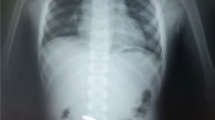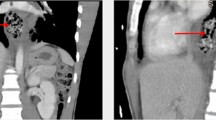Abstract
Background
In the 1970s in part to avoid inadvertent ingestion, the beverage-can industry changed can construction from pull-tabs to the stay-tabs (remain attached to can after opening) used today.
Objective
Our purpose is to identify the number of inadvertent ingestions of beverage-can stay-tabs by children recognized at our institution.
Materials and methods
The medical information system of a children’s hospital was searched with key terms to identify cases in which a witnessed or self-reported inadvertent ingestion of a beverage-can stay-tab resulted in a radiograph to rule out presence of a foreign body. Demographics, identification of stay-tab on radiographs, associated abnormalities, and patient management were reviewed.
Results
Nineteen cases of stay-tab ingestion were identified over 16 years. Mean age of ingesters was 8.5 years with the majority being teenagers and 15 (79%) >5 years of age. The stay-tab could be seen radiographically only in 4 (21%) cases—all with the stay-tab identified in the stomach.
Conclusion
The identification of 19 children who inadvertently ingested beverage-can stay-tabs at a single children’s hospital suggests that such ingestions still occur. Radiologists should be aware that stay-tabs are radiographically visible in the minority (21%) of cases.




Similar content being viewed by others
References
Rogers LF, Igini JP (1975) Beverage can pull-tabs: inadvertent ingestion or aspiration. JAMA 233:345–348
(1976) American College of Radiology and the Eastman Kodak Company Cooperative Program in Public Information: annual report. American College of Radiology and the Eastman Kodak Company, Reston, VA, pp 10-11
Donnelly LF, O’ Hara SM, Oestreich AE et al (2009) Interaction between academic radiology and the news media: a potentially powerful and unpredictable process—five stories. AJR 192:1382–1387
Eggli KD, Potter BM, Garcia V et al (1986) Delayed diagnosis of esophageal perforation by aluminum foreign bodies. Pediatr Radiol 16:511–513
Bradburn DM, Carr HF, Renwick I (1994) Radiographs and aluminum: a pitfall for the unwary. BMJ 308:1226
Valente JH, Lemke T, Ridlen M et al (2005) Aluminum foreign bodies: do they show up on x-ray? Emerg Radiol 12:30–33
Hunter TB, Taljanovic MS (2003) Foreign bodies. Radiographics 23:731–757
Donnelly LF, Frush DP, Bisset GS (1998) The multiple presentations of foreign bodies in children. AJR 170:471–477
Litovitz T, Schmitz BF (1992) Ingestion of cylindrical and button batteries: an analysis of 2382 cases. Pediatrics 89:747–757
Oestreich AE (2009) Worldwide survey of damage from swallowing multiple magnets. Pediatr Radiol 39:142–147
Cauchi JA, Shawis RN (2002) Multiple magnet ingestion and gastrointestinal morbidity. Arch Dis Child 87:539–540
Oestreich AE (2006) Danger of multiple magnets beyond the stomach in childen. J Natl Med Assoc 98:277–279
Oestreich AE (2007) The usefulness of magnification in post-gastric magnetopathy—technical innovation. Pediatr Radiol 37:1268–1269
Durback LF, Wedin GP, Seidler DE (1988) Management of lead foreign body ingestion: case report. J Emerg Med 6:397–400
O’Hara SM, Donnelly LF, Chuang E et al (1999) Gastric retention of zinc-based pennies: radiographic appearance and hazards. Radiology 213:113–117
Author information
Authors and Affiliations
Corresponding author
Rights and permissions
About this article
Cite this article
Donnelly, L.F. Beverage can stay-tabs: still a source for inadvertently ingested foreign bodies in children. Pediatr Radiol 40, 1485–1489 (2010). https://doi.org/10.1007/s00247-010-1651-5
Received:
Revised:
Accepted:
Published:
Issue Date:
DOI: https://doi.org/10.1007/s00247-010-1651-5




